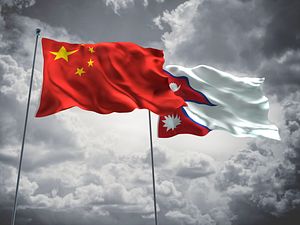On September 1, Nepal’s Prime Minister Sher Bahadur Deuba announced the formation of a committee to “study” the border dispute between Nepal and China in Humla. The committee will study the alleged construction of 11 houses by the Chinese side on Nepali territory between border pillars 11 and 12 in Humla district of Western Nepal.
The issue came to the fore a year ago, when Prime Minister K. P. Sharma Oli was at the helm in Nepal. Deuba’s Nepali Congress was in the opposition then and its legislators were vociferous in their allegations that China had encroached Nepali territory in Humla district.
Nepal shares a 1,439-kilometer-long border with China. The border is remote and inaccessible in large parts due to its difficult terrain and complex geography. The frontier between the two states is based on the 1961 Border Treaty, and the various protocols signed thereafter. It is marked by 100 main and subsidiary pillars.
However, minor disputes over the border have surfaced between the two countries occasionally, mostly due to natural causes.
The “dispute” regarding the construction of 11 Chinese buildings on the Nepali side of the territory in Humla came to the fore after Indian newspapers reported Chinese encroachment in June 2020, with some even describing it as “Chinese expansionism.”
Nepali media followed up on the issue. They drew on a 2017 report by Nepal’s Ministry of Agriculture, which alleged that China had encroached upon Nepali territory in ten places.
The news spread widely via social media. The Ministry of Foreign Affairs (MOFA) and the Ministry of Agriculture denied the said “report” existed and clarified that the Ministry of Agriculture has no jurisdiction over the issue.
The Oli government then directed the Chief District Officer (CDO) of Humla district to study and submit a report. The findings have not been made public, but newspapers quoted the CDO as saying that the construction seems to have taken place 1 kilometer inside Chinese territory.
However, before the CDO concluded his report, MoFA reaffirmed that the construction had not occurred in Nepali territory. The statement also stated that an inter-ministerial team had concluded that China had constructed some buildings within Chinese territory in 2016. China also stressed that the construction had taken place on Chinese territory and denied there was any territorial dispute between China and Nepal.
The Nepali Congress called the MoFA hasty and condemned the statement made without waiting for the report from the investigation by local authorities. It tabled a resolution in parliament calling on Prime Minister Oli “to bring back these encroached territories by holding dialogue” with China.
Unsatisfied with the report, a team led by Jeevan Bahadur Shahi, a Nepali Congress lawmaker for Karnali Province, visited the site. He alleged that China had encroached into Nepali territory and replaced a pillar in such a way that a large chunk of Nepali territory had gone into China.
The allegations led to protests in front of the Chinese Embassy in Kathmandu, where protestors chanted slogans calling a “stop [to] Chinese intervention” and to “Chinese encroachment.” Nepali Congress leaders accused the Oli government of appeasing Beijing and remaining quiet when China had encroached on Nepali territory.
China’s interventions in Nepal’s domestic politics, in particular, its encouragement for the country’s two major Communist parties to merge and form the Nepal Communist Party (NCP) government that Oli led, had previously been criticized by the Nepali Congress. The Nepali Congress was also upset with the Oli government’s dismissive response to the allegations of Chinese encroachment.
Now in power – the Nepali Congress formed a minority government in July with the support of the Maoist Center, which was earlier a part of the Oli government – Deuba is obligated to act on his earlier allegations against China.
But there are problems.
The Maoist Center is of the view that the border dispute with China is an item on the Nepali Congress’ agenda rather than a national issue. This difference is reflected in the Common Minimum Program (CMP), the coalition government’s set of common goals and policy preferences. While the CMP mentions the Kalapani dispute with India, it is silent on the border dispute with China.
This makes it difficult for Deuba to act robustly on his allegations.
Deuba seems to have appointed the committee to study the Chinese border issue to divert attention away from other issues he is grappling with.
Nepal recently amended its constitution to include Kalapani, Lipulekh, and Limpiyadhura (territories also claimed by India) as Nepali territory, ruffling feathers in New Delhi. He is now under pressure from the U.S. to approve the Millennium Challenge Compact, a $500 million aid pact, which has divided political and public opinion.
Deuba is trying to burnish his credentials as a nationalist leader, who deals with India and China in a “balanced” way. He has a lot on his plate, and this balancing act may have ironically increased the load.
Recent developments underscore the fact that although it is the federal government that has the sole purview of crafting foreign policy, activities by local and provincial leaders is complicating Kathmandu’s conducting of relations with foreign governments. Additionally, Nepal’s policy on its border disputes is getting mired in partisan politics.
Moving forward, Nepal and China should sign the digital boundary map signed in 2005-06, but not signed over a missing pillar and the dispute over the height of the Everest. Both of these conflicts have been resolved now. The government should also engage opposition parties in any discussion that could impact Nepal’s foreign and security policies in the long term. Now that a committee has been set up, the government should report the findings in a transparent manner and call for a national discussion.
































